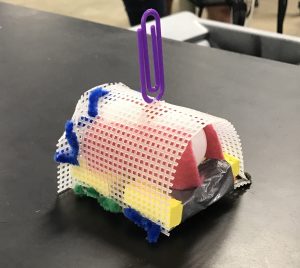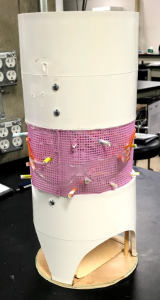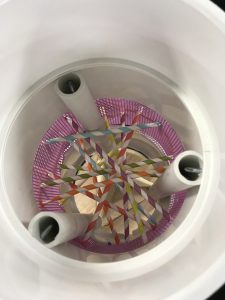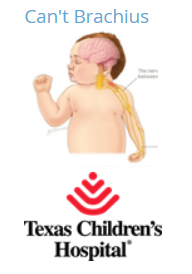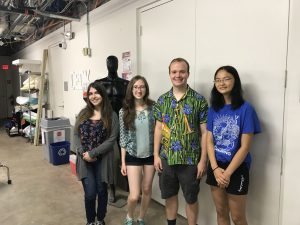This week at SEED, we bid our enrichment devices farewell and began our major summer-long projects.
Monday was entirely devoted to prototyping. To introduce us to the prototyping process, we kicked off the day with the Bajaj challenge. The bajaj is a three-wheeled vehicle found in Ethiopia, that carries passengers up to 40 MPH without any seat belts or real doors. It is the ride of a lifetime and a ride for your life. Dr. Wettergreen tasked us with constructing a bajaj using the various treasures found in the low-fidelity cart that can hold two ping pong ball passengers for the entirety of a zip-line ride. Julia D. and I constructed a plastic mesh bajaj with foam seats. Our bajaj was able to guarantee the safety of at least one passenger every time (at the sacrifice of the other)!
We continued with low-fidelity prototyping in our zoo teams. After pugh screening, Team Lion selected an enrichment device based off the game Kerplunk. In Kerplunk, you pull out the straws in the center of the toy to allow marbles at the top to fall. Our device would resemble a plastic tube with holes in the middle for browse (a type of leafy plant). When tapirs pull out the browse, additional food would fall down the tube for them to eat.
We created multiple low-fidelity prototypes featuring different bases and attachment mechanisms. In the end, we chose the design with four legs at the base, surrounding a pyramid that allowed food to slide down. Medium-fidelity prototyping began after lunch. We constructed our device using PVC, rainbow straws, pink mesh, and scrap wood. After performing some tests on our device (like knocking it around to test durability), we proudly unveiled our prototype before the rest of SEED on Tuesday. We dubbed it the Taplunk. Just like the Kerplunk has enriched humans for decades, we hope the Taplunk can one day enrich the lives of tapirs around the world.
Tuesday marked the official end of bootcamp. As much as I would miss the engineering design videos and the Taplunk, I waited in anticipation for the announcement of our major project. We heard pitches for three projects and ranked the three based on our preferences. I was extremely happy to get my first pick: creating a model for infant brachial plexus injury!
The brachial plexus is a network of nerves that controls the shoulder and arm. Some infants injure their brachial plexus during birth and require physical therapy to avoid developing paralysis in their arm. This project is a continuation of a past ENGI 120 project. Our team, in collaboration with James Northcutt at the Texas Children’s Hospital, will develop a physical model to teach parents the therapy movements they should perform on their infants. The model should show both normal and abnormal shoulder movements associated with brachial plexus injury. We spent most of Thursday and Friday reading documents written by the previous ENGI 120 team and slogging through medical articles (the glenohumeral joint? What even is that?). It’s going to be tough modeling the human shoulder, with all its bones and connections, and it’ll require careful mechanical design on our part. I’m excited to see what our team comes up with and hope to learn a ton of things along the way. Next week, we’ll continue researching and begin brainstorming. Until next time!
P.S. The featured image is a baby mannequin we found. We definitely will not be modeling our final device after that.

